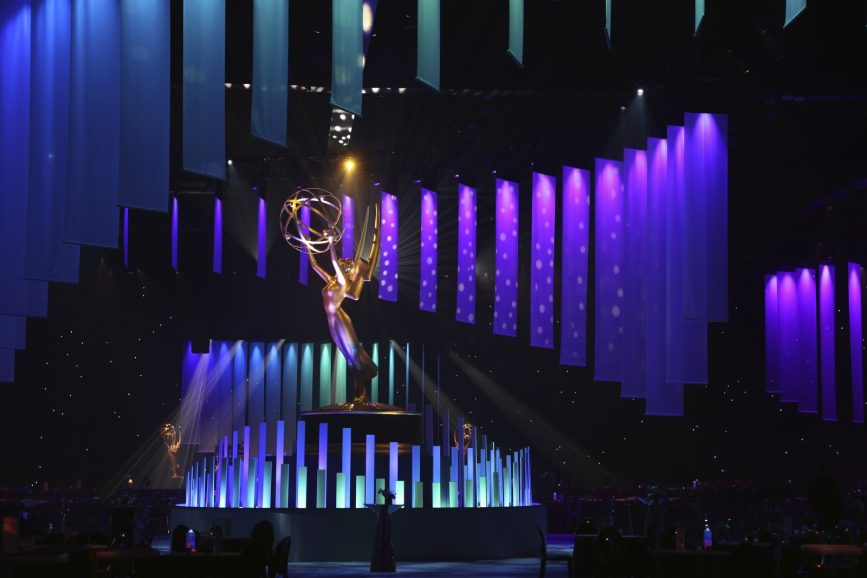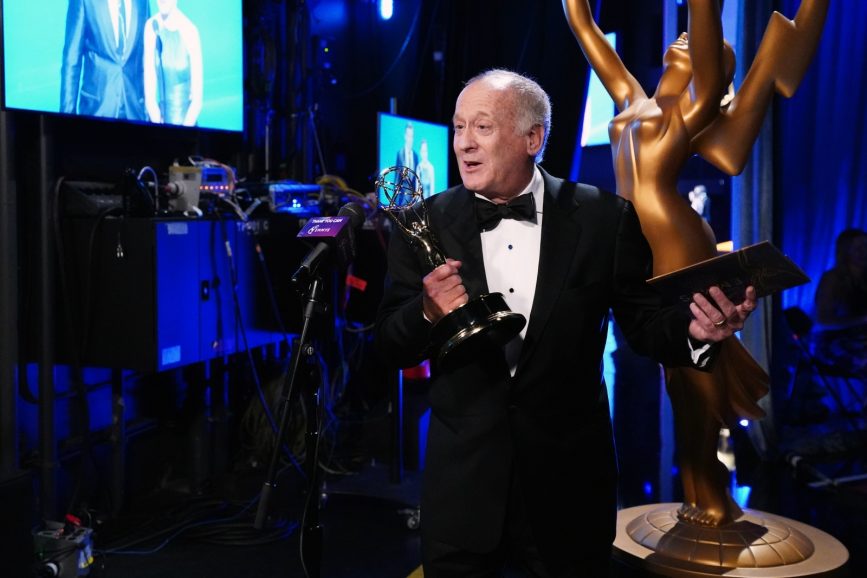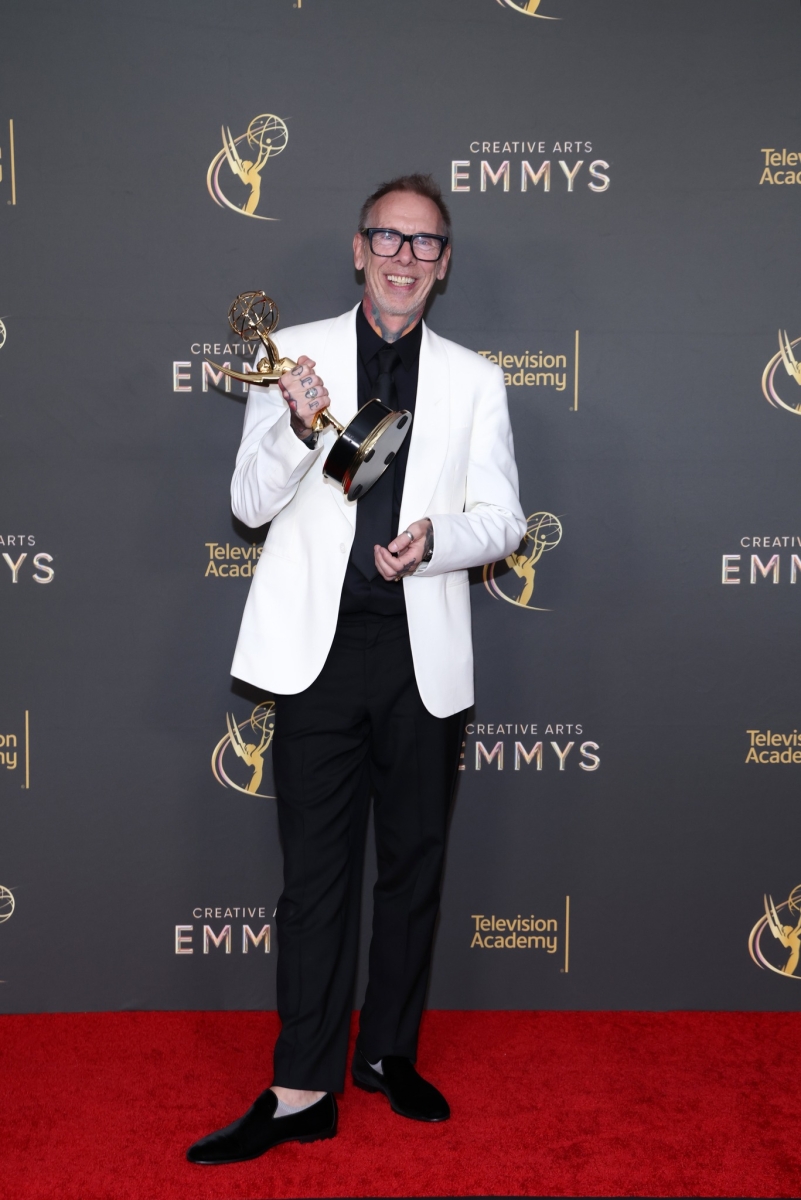Mark London Williams explores the complex interplay of creativity and technology in cinematography as Emmy winners reveal their artistry behind impactful storytelling.
September came in like an Emmy award and went out like one, too. The winged statuettes were handed out at the top of the month, and their larger than life versions decorate the Television Academy, where the Emerging Cinematographer Awards were once again held, just as the month was yielding to October.
Ruminating on calendars though, you may be telling yourself that we “just had” an Emmys, and you’d be right. Strike delays pushed the 75th Creative Arts gathering to the same January weekend as the Golden Globes. This time, for number 76, they returned to their traditional autumn spots, the two-night Creative Arts Emmys followed by the live broadcast of the “Primetime” edition a week later. The Outstanding Cinematography categories still had to wait until the end of the second evening, when winners were announced in the one hour, half-hour, multi-camera, and limited or anthology formats, all coming quickly and making for a memorably frenetic series of overlapping Q&A’s backstage.

Though to be fair, there were certainly some cinematography-by-any-other-name categories the first night, too, such as the two Saturday Night Live came away with (as part of its total of six), including one for “Outstanding Lighting Design/Lighting Direction for a Variety Series,” (recall that in early film biz days, directors of cinematography were sometimes called directors of lighting) as well as “Outstanding Technical Direction and Camerawork for a Series.”
When the latter group made its way back to the media room, we asked how much had changed over the show’s 50 years, in terms of that technical side, and they mentioned not only aspect ratios – going from 4:40 to 16:9 as home sets elongated, but also that “we used to shoot graphics on an easel! The equipment,” they understatedly concluded, “has gotten much better.”
Saturday was also the day for “non-fiction” programming – a.k.a. documentaries. Apple TV’s Girls State won not only for its cinematography, but its direction. Backstage, DP Laura Hudock, thanked fellow DP Thorsten Thielow, who couldn’t be there out of the half-dozen- plus winning cinematographers, who each followed a different “girl’s” narrative, as they met over a summer to form a mock government. Since that gathering came in the wake of the Supreme Court’s Dobbs decision, casting a sudden stark light on what “girls” and “politics” now meant in the same sentence, Hudock called the “release of this film incredibly timed.” Given that participants came from households “of different parties and politics,” she noted the “incredible serendipity” of its release – and now its wins.
Life Below Zero – about the precarities and travails of everyday life in Alaska – added to its ongoing Emmy total with its own win for cinematography in the reality series division, for its “Bulletproof” episode, with producer/DP Charlie Beck, longstanding series DP Michael Cheeseman and their operators backstage, espousing a similar approach to Girls State – deploying their Canon and Sony cameras, drones, etc., to “capture the real moments as we they happen – making sure we show our cast members in (their) environment.”
On the one-hour narrative side the next day, it was little surprise when the recently – and insistently – retired Robert Elswit ASC won for his work on Netflix’s Patricia Highsmith adaptation, Ripley. Earlier this same award season, another DP, who shoots a well-known chef show, thought that given Elswit was shooting in B&W, with gorgeous period support in costumes and production (both of which were also nominated), and primarily on location in Italy, including the Amalfi coast, well, this DP reasoned, shouldn’t there be some kind of handicap for the work, as in golf, because who, really would be able to compete against the visuals provided by that kind of environment?

He was joking, though only sort of, and perhaps even Elswit wouldn’t disagree, saying in his acceptance speech that he felt “like such a fraud.” When we asked him to elaborate backstage, he talked of “show(ing) up almost a year later” for the project, after writer/director Steven Zallian (who would win his own directing Emmy the following week), had amassed the “very inspiring” pictures he’d taken with his location manager, on numerous scouts. Elswit also credited an “extraordinary series of screenplays,” and Zallian’s decision to use black-and-white to “create a sense of the character,” and enhance “the extraordinary tension,” and the “luck [of having] a great production designer and a great Italian crew,” as all contributing to his win.
And a pretty great VFX crew as well, as the show also won for “Best Special Visual Effects in a Single Episode” (Emmy categories tend to be longer and more specific than their Oscar counterparts). Backstage, the group called Elswit’s black-and-white cinematography a “touchstone” for their own work extending period backgrounds, watery graves, and more. They also mentioned the grayscale and shadows presented their own challenges, since something as simple as blood – and blood is pretty critical to the show – “reads as blood because it’s red.”
Working not in black-and-white, but certainly in period, was Sam McCurdy ASC BSC, winning in the limited series/movie category for the “Crimson Sky” episode of FX’s Shōgun, which took 18 of the 25 categories it was nominated for, setting a new Emmy record (though one already established on the Creative Arts side before the above-the-line gathering even took place).

In asking how it felt to be up against colleague Christopher Ross BSC, nominated for a different Shōgun episode (and clearly not splitting votes in a way that handed the category to someone else), he said “being dear dear friends with Christopher,” it really hadn’t felt like “competition” at all. Especially with Ross helping set the look and tone (in his also nominated series opener “Anjin”) thus allowing McCurdy to “push the visuals” later. He, Ross, and the entire team made use of the numerous “historical advisors on the set,” along with references from “paintings or (other) historians,” which helped make “some really key choices for us, in terms of lighting. They were very specific, (down to the way) oil lamps were used,” or even which doors in a household would be open, or not, in terms of where and how light would be let into a room.
Meanwhile, going Shōgun one better was Gary Baum ASC, who competed against himself in the multi-camera category, one he pleaded with the Academy to keep in his acceptance speech. He won – his fourth Emmy overall – for the “Okay Fine, It’s A Hurricane” episode of How I Met Your Father and was also nominated for his work on Frasier.

Backstage, he linked the two, saying his work on Father was an outgrowth “of what we did on Frasier,” shooting for three days in multi-cam style, though with an added day of single camera work and pickups. And he “used the same equipment,” Panavision glass on a Sony VENICE, though on Father “we (also) had other equipment (like) a Jib (and) Steadicam,” allowing visuals on the latter to be “a little more intense.”
No stranger to intensity, FX’s food-and-family-angst hit The Bear also took home several awards, including for DP Andrew Wehde, for the episode “Forks.” He later talked of working with Panavision to help develop “The ‘Bear’ from its earliest episodes.
He described it as “a little bit of a split tone, colour, vintage lens – naturalistic,” with “a lot of zooms. We treat each moment, and every scene as its own little movie,” with some movie makers, like “early Michael Mann (and) Tony Scott,” cited as specific inspirations, for “that kind of dark thriller feel we bring into Chicago when we can.”

And even when they can’t, they’re referencing something else, as in “Fishes,” which Wehde said was “a little bit more like our ode to The Godfather. A tribute,” he added, “to the artists we love.”
The quartet of cinematography awards provided a good prism for the Emmys overall, reflecting a comment that winning Bear guest actress Jamie Lee Curtis made earlier (guest stars and animation are among the additional categories awarded on Creative Arts weekend), when she talked of “selling yogurt that makes you shit, for seven years” in the middle of her acting career, never thinking she’d get to do “work at this level of complexity and intelligence.”

There were many such notes of gratitude backstage, and we’ll get to a couple more in a moment, but before the busy-ness of fall completely overwhelms us, let us quickly note a couple projects from late summer, also of complexity and intelligence, that came our way.
One was the Mexican-produced series Women in Blue, on Apple TV+, shot in part by Sarasvati Herrera, who did the fifth and sixth episodes, as well as serving as the second unit DP for the entire show. In capturing its gritty, almost Sidney Lumet-esque feel – which is about a group of women hired by Mexico City’s police department in the 70s, to provide more of a PR gloss in the face of a serial killer investigation (a premise suggested by actual events) –she used a Sony Venice II, Cooke S4 uncoated lenses and Angénieux zooms, “to recall the use of zooms in the 70’s.”

Her work “started from the beginning of the series (with initial DP) Alejandro Martinez, who established the look for the series (and) got us into his preproduction process, creating a manifest for all of us to follow…The use of the same LUT was (also) very important for consistency (as well as) watching the rushes every day and visiting each other’s sets.”
Filmic references included killer-centered movies like Se7en, Zodiac, Munich, and even older ones like M, and The Conformist,” the latter with Vittorio Storaro’s great work, prompting Coppola to initially want him for The Godfather (though Gordon Willis ASC didn’t work out too badly, as the folks on The Bear will attest), finally collaborating with him on Apocalypse Now.
“Another important element,” Herrera adds, “was the set. Production Designer Carlos Lagunas recreated the police station in a studio, bringing furniture from the 70s and taking care of every detail. It was amazing to reach for a folder from a shelf and find, in most cases, a real document. It really felt like traveling in time.”
Also traveling back in time – though not nearly as far – was the indie release Didi, set in this columnist’s native East Bay Area, but circa 2008. Described as a “Myspace-era coming-of-age tale,” from writer/director Sean Wang (himself an Oscar nominee earlier this year for his short doc Nai Nai & Wài Pó, about both his grandmas), it stars Izaac Wang (no relation) as a version of young Sean, who is trying to find himself within his own, relatively recently arrived immigrant family, and at the outset of the usual turbulence of adolescence – while also trying to find his “voice” as a young videographer of skateboard culture, and in his various online identities at his early 21st century websites (yes, Myspace included).
Shot by Sam A. Davis (who shared that Oscar nomination with Wang), we spoke with Arielle Zakowski (who edited along with Christopher Tennant) about how she worked with all those disparate visual sources – including those lower-res screens the characters spend time with – to smooth out the story’s visuals.

She credits Wang and Davis with finding “a really naturalistic and beautiful style to capture the earnestness of the story. The internet scenes were woven into the movie at the script level, but we definitely continued to push and explore them in the edit. The first time we jump ‘into the computer,’ so to speak, it can take audiences a moment to orient themselves and realize what we’ve done. But most people catch on quite quickly and are along for the ride. The fact that these scenes are so motivated by the story always helps justify their presence… Nothing quite says ‘this is 2008’ like trying to construct the perfect AIM message to send to your crush…
“Chris and I animated all of the sequences in Adobe Premiere and After Effects. Aodhan Ozawa Burns built the majority of our 2008 assets in Illustrator, thanks to lots and lots of digging through the Internet and painstaking recreation. (Title and graphic designer) Joyce N. Ho designed the characters’ MySpace pages which are so fun and such great reflections of each character. Nick Johnson (who helped pioneer this process on the film Searching) was our constant guide and even jumped in to help when we were up against the clock. Couldn’t have brought any of it to life without this team!”

It all further illustrates how much “image capture” – and whatever is still meant by that in our networked, AI-riven, digitally-infused world – is changing, for cinematographers, and everyone else.
The very world which this year’s crop of winning Emerging Cinematographers – in the 26th year of ICG Local 600’s awards – are entering. As ever, the full weekend kicked off with a Friday luncheon at the ASC Clubhouse, an agent’s day on Saturday (media isn’t brought along for that one), and the actual presenting of awards, and screening of films, at a Sunday evening reception, held once again at the Television Academy (where those large Emmy statues were in evidence!)

Awards co-chair Stephen Poster, ASC (and fellow BC magazine scribe!) acknowledged in his opening remarks it’s been a “tough season” the last couple years for, well, everybody – not just cinematographers, echoed by Local 600’s executive director Alex Tonnison, who said that while “we’re all feeling the contraction,” Hollywood’s history has been one of cyclic changes.
One of the ways to help each other through those cycles, emphasised M. David Mullen ASC, the multiple-Emmy winning DP on the Marvelous Mrs. Maisel, and recipient of the ASC Mentor Award, is to always be willing to help colleagues – established, or up-and-coming. Both he and Poster shared stories of how the late E.T. cinematographer, Allen Daviau ASC, had helped both of them at critical junctures early in their careers.
On Sunday, after Mullen had gone back to Paris to work on the new ballet-themed series from Maisel’s creators, Rodrigo Prieto ASC, AMC had arrived to accept his Distinguished Filmmaker Award. He noted that when he has a question, “I call David,” and feels like “I’m an emerging cinematographer every day. Other cinematographers are my mentors.”
Advising everyone there to “keep making films through your lenses and through your hearts,” it was then time for for the winning films themselves, a lively melange of documentary, drama and genre work, ranging from the impacts of the Boston Globe’s Spotlight section, to historicals, Star Wars fan fic (!), and even a terrific, Maisel-era period piece on the break-up/rebirth of a Nichols & May-like comedy duo.
What awaits these “makers of film,” in Prieto’s phrase, remains to be seen, of course, as it does for all of us in this acutely felt moment. Back at the Creative Arts Emmys, day one ended with a win for Dick Van Dyke 98 Years of Magic for “Outstanding (pre-recorded) Variety Special.” He came backstage with his wife Arlene, one of the show’s winning producers. Sitting on a stool for the Q&A, we were struck with the realisation that for most of us, this would be not only the first time we were ever in the room with the television legend, but the last, as well. He, in fact, joked that he was inviting us all to his memorial, but he “doesn’t have a date yet.”

He acknowledged that there was likely “a little sentiment involved in the award,” but he was genuinely grateful. And maintaining that certain twinkle, said he “used to fall down for a living – now I just fall down!”
When a pause came at the end, after he asked if there were any more questions, he said it was just as well, as “I don’t have any more answers.”
It was one of those moments where the rondel of award shows can transcend themselves, and like the work that’s being honoured hopefully does, connect with larger considerations. That was underscored earlier that same evening, when Maya Rudolph came backstage after her win for her voiceover work in the animated series Big Mouth.

A colleague asked her about her anticipated return to Saturday Night Live, for its 50th season, to play the Kamala Harris role she’d established during previous election cycles (which of course she would do in this season’s cold open, a couple weeks later). She answered that not only was SNL a “my favorite place to go to work,” but more seriously, “I feel like I am connected somehow to an incredible time in this country – and I’m very honoured to be associated with that.”
Again, the overlap of the pretend and the real, that draws so many to this business, or even to writing about it.
On which note, it is not only an incredible time here across the pond, but a rather definitive at-the-crossroads one, as well. So we’ll be waiting until after election day to file our next dispatch, when we’ll have a much clearer idea of exactly what kind of country we’re reporting from.
Until then, happy Halloween.
@TricksterInk / AcrossthePondBC@gmail.com










